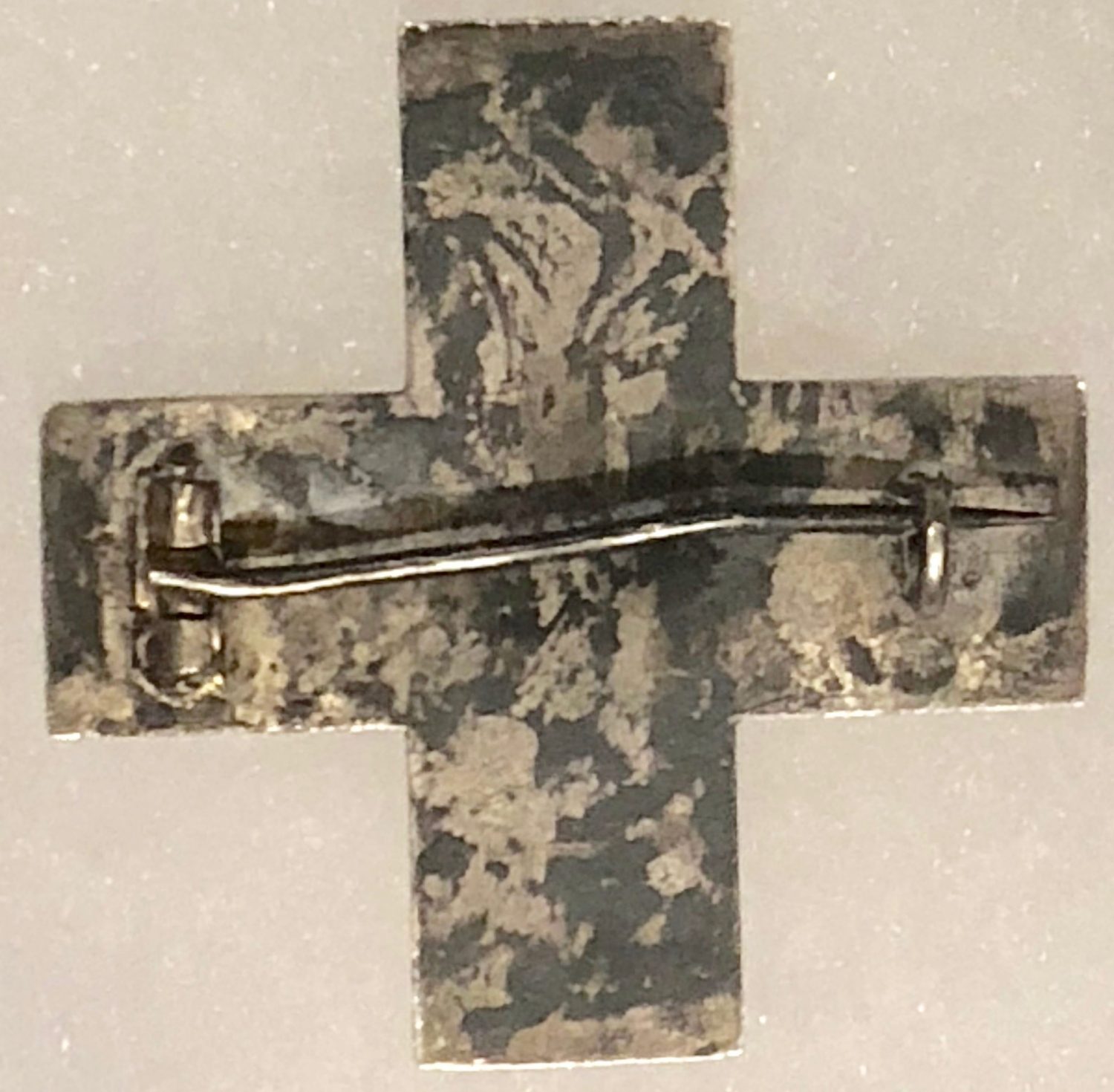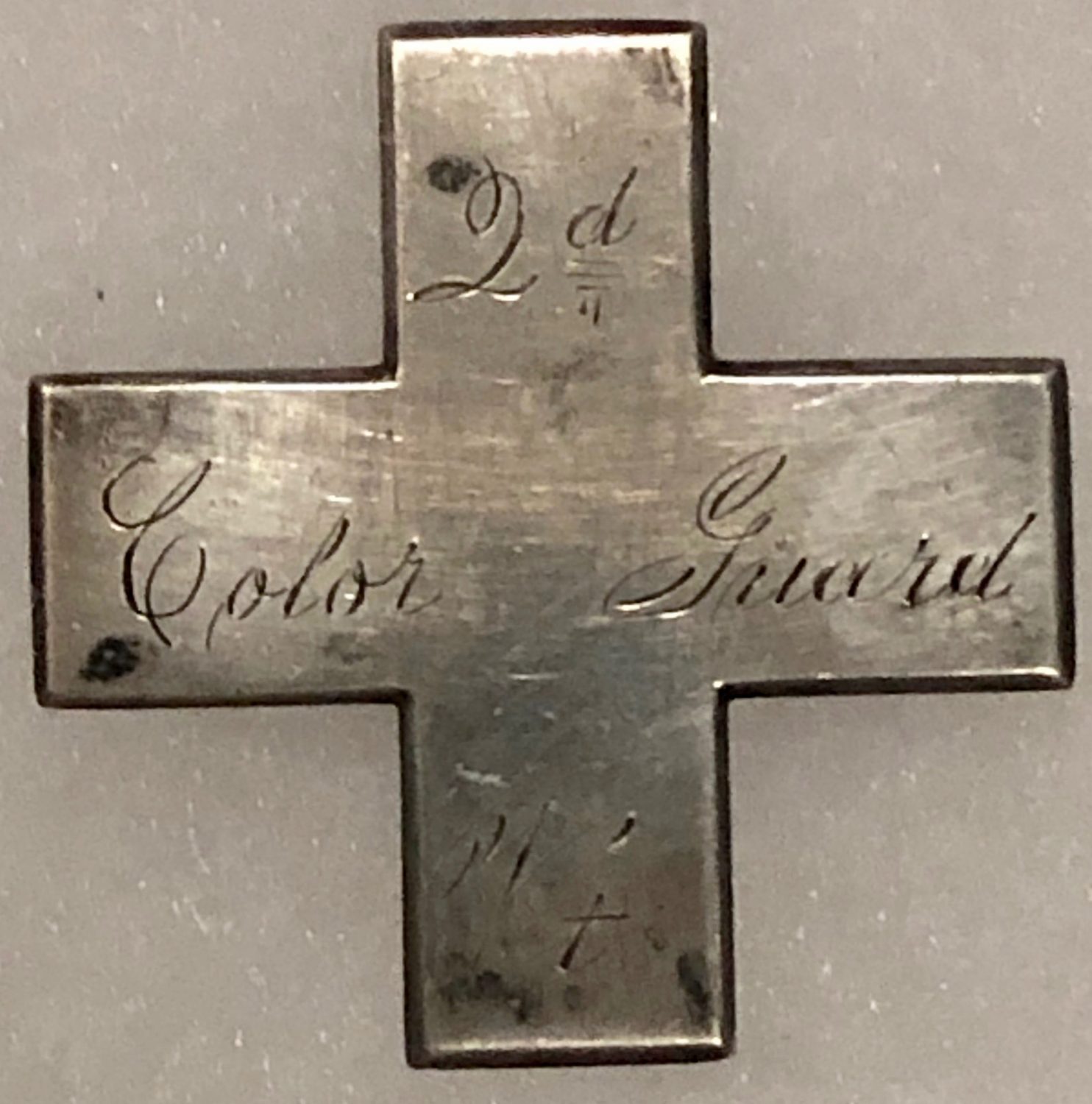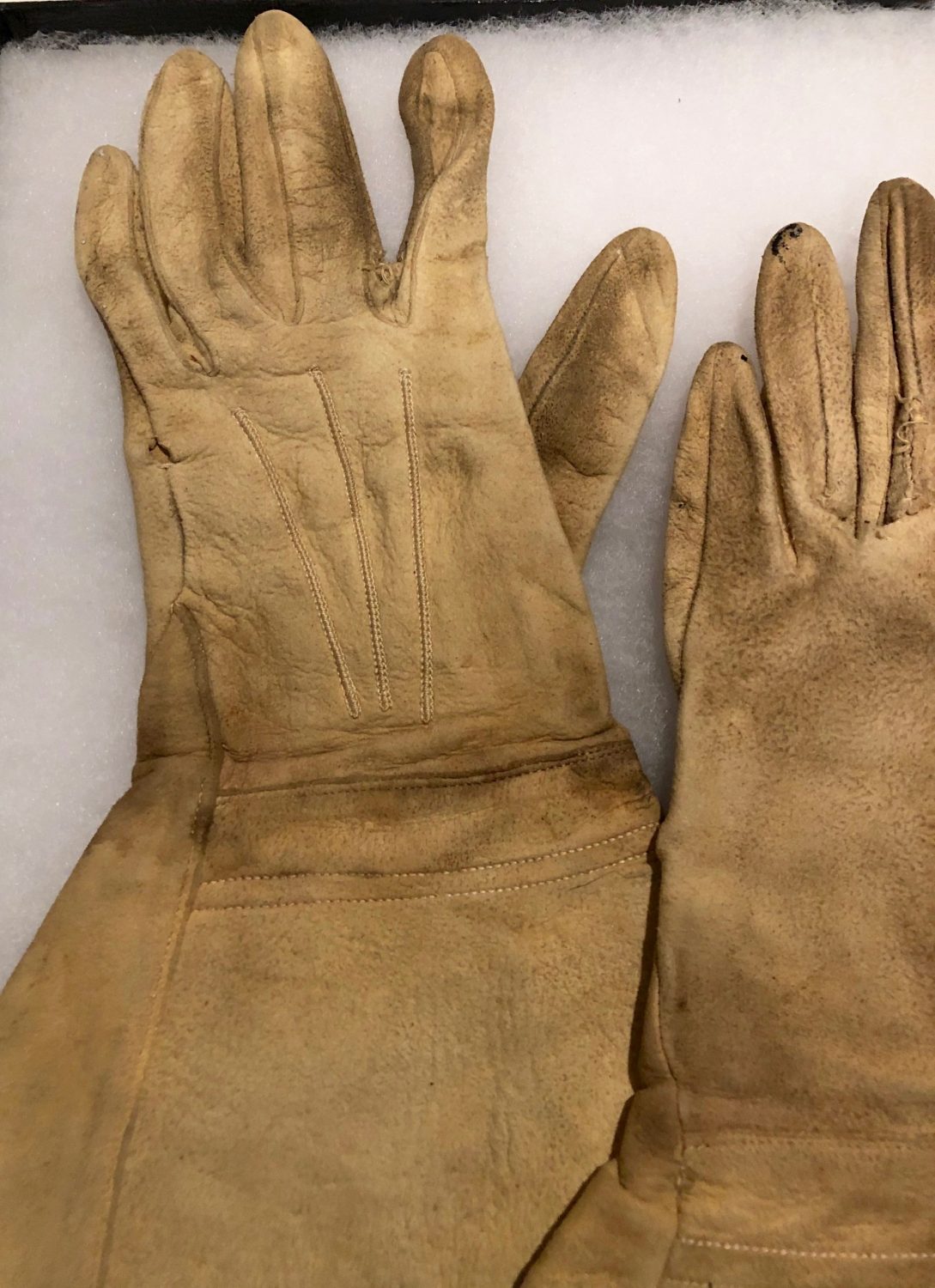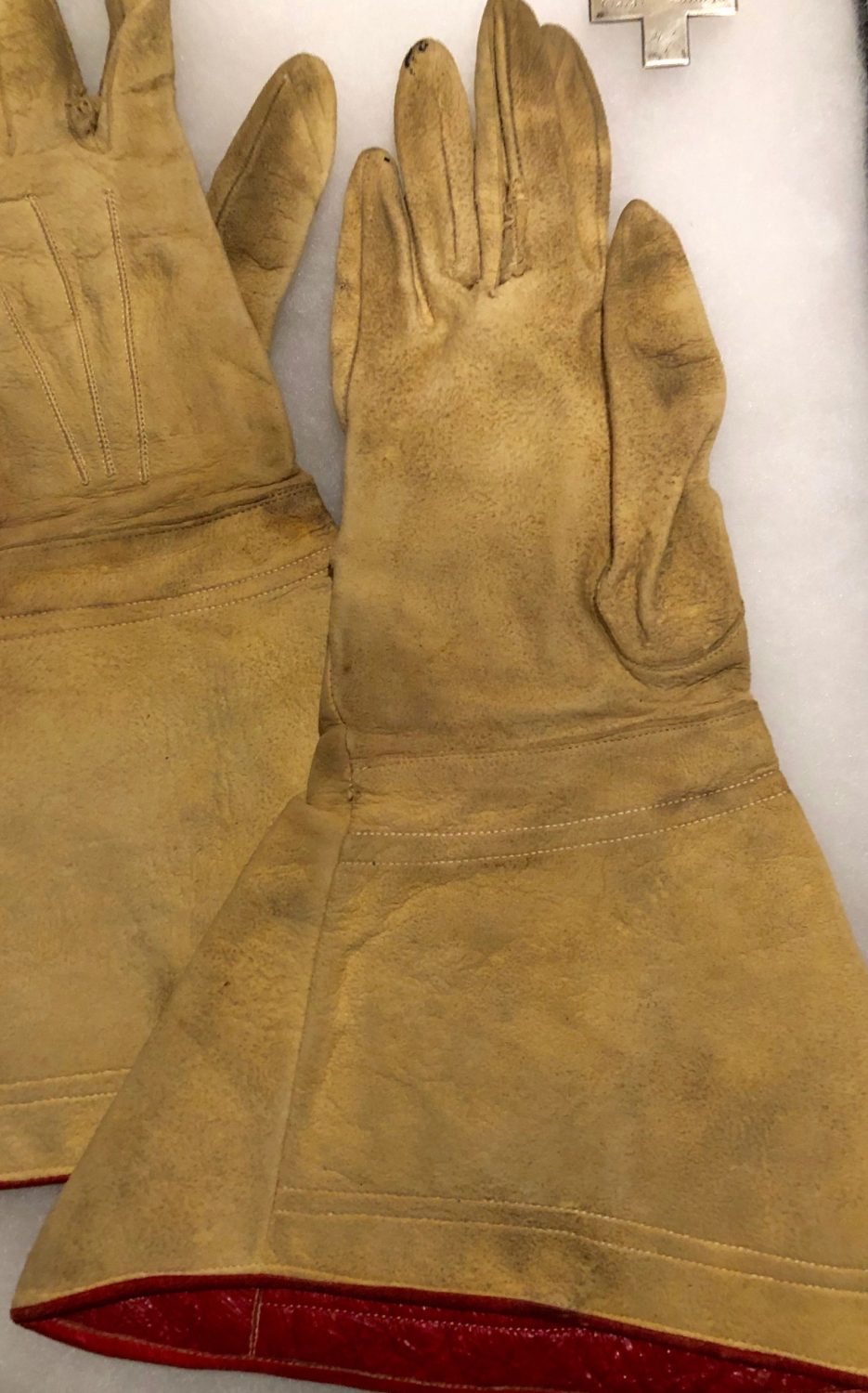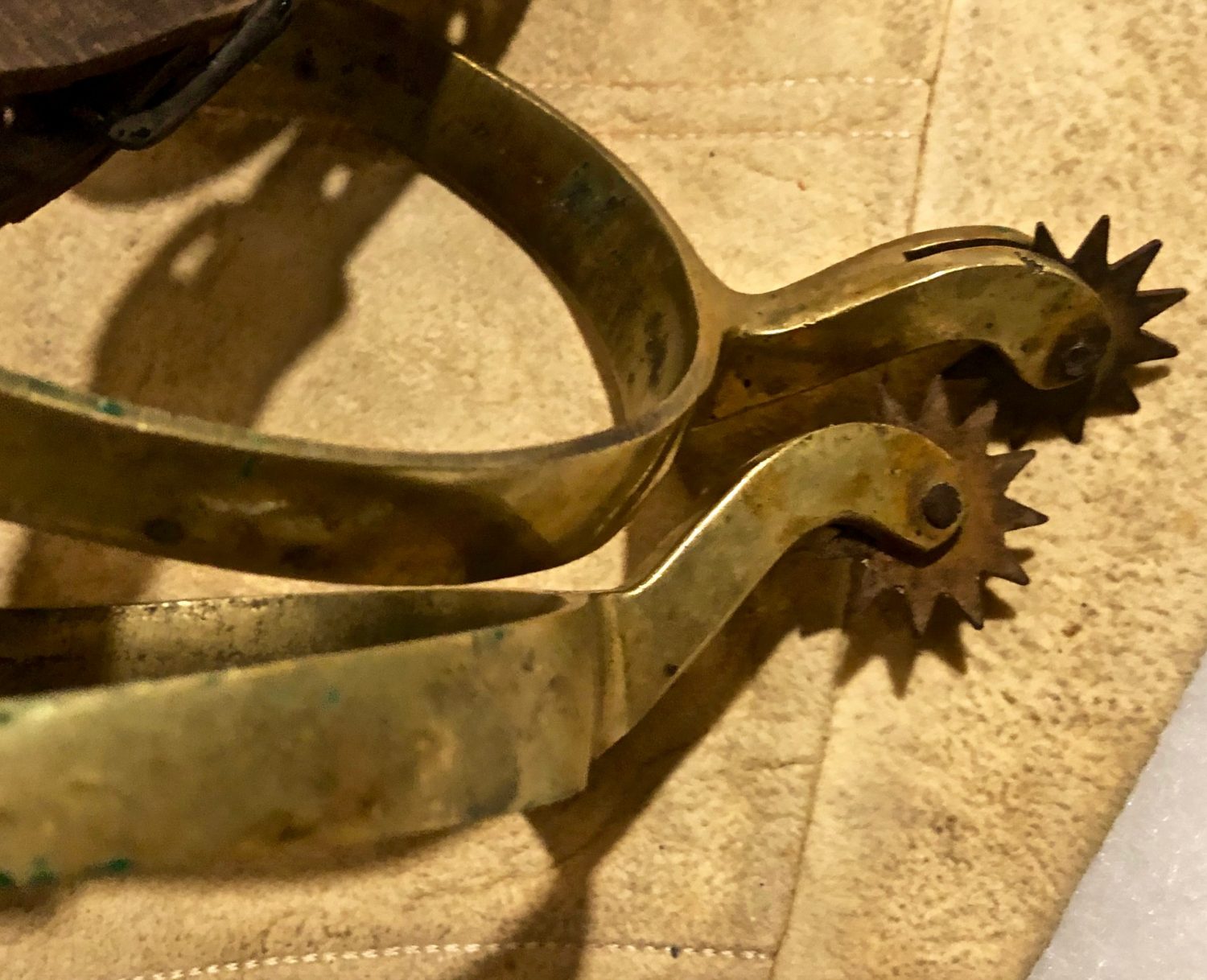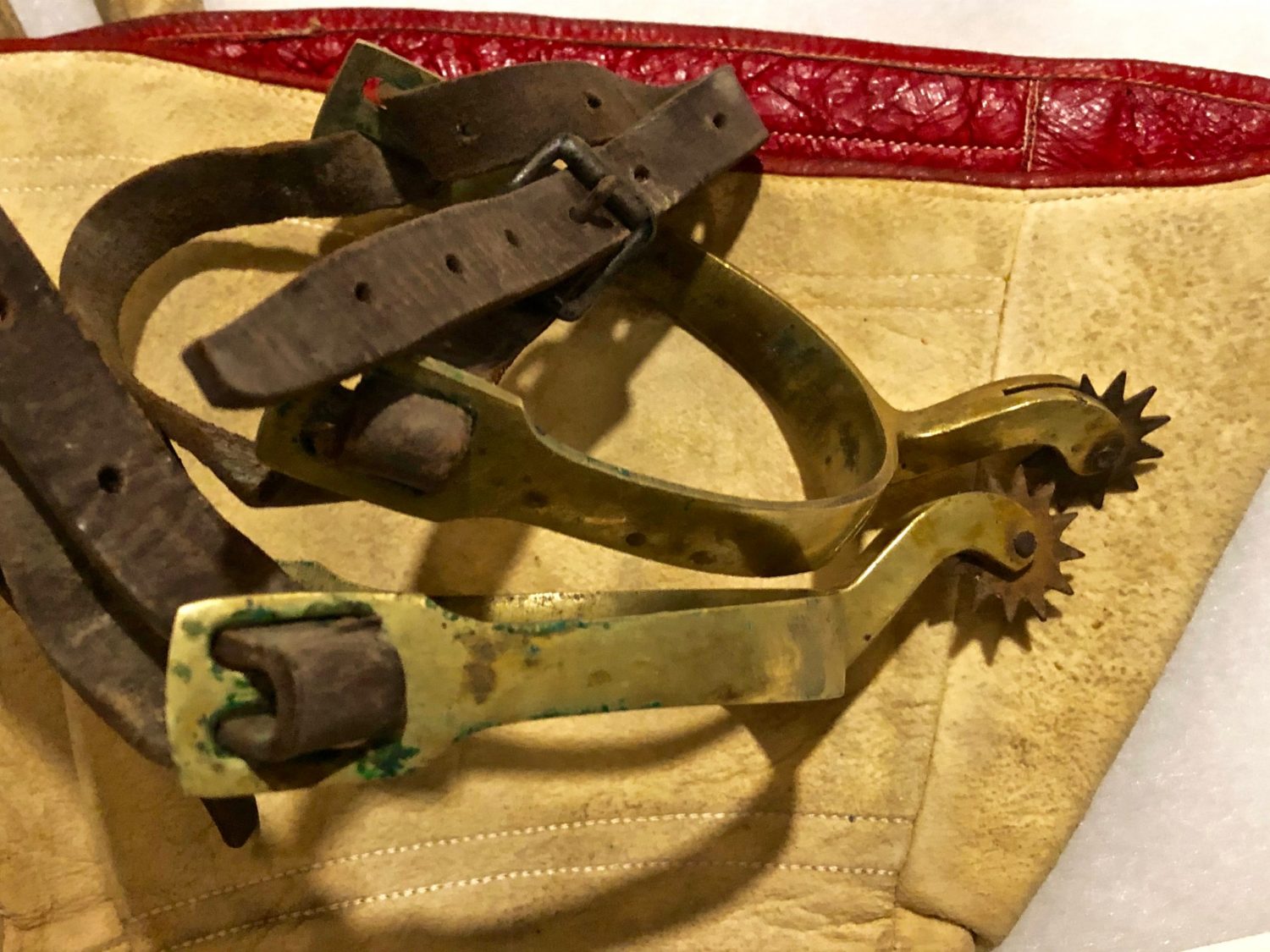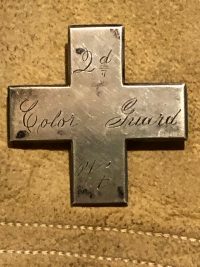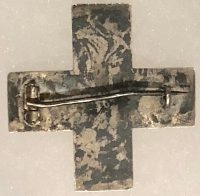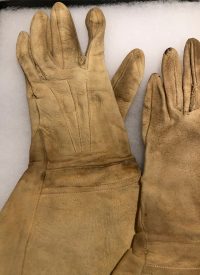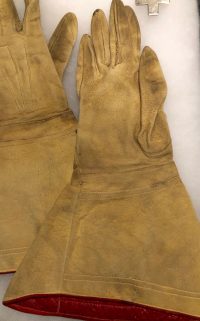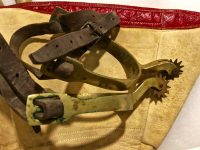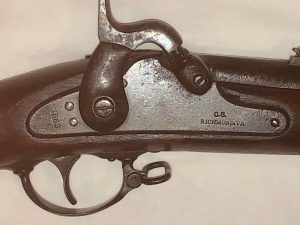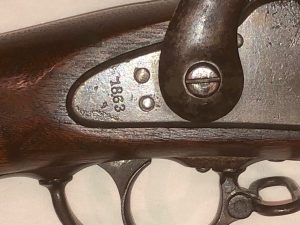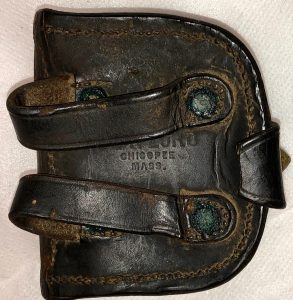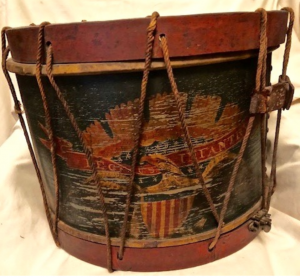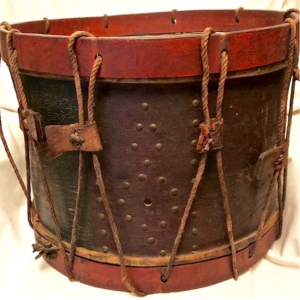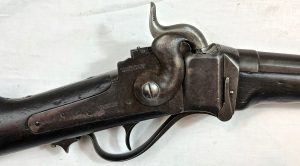Id’d Vermont, WIA, Civil War Soldier’s Gauntlets, Silver Corps Badge and Spurs
Comprising this Id’d grouping are the following: fine condition, war period gauntlets; excellent condition, silver 6th Corps badge – engraved on the front of the badge is: “2d / V’t / Color Guard” – badge has the correct, war period “T-pin” mode of attachment affixed to the back of the badge; nice, private purchase pair of pre-war, brass spurs, with leather, spur straps; soldier’s calling card – all of these items were owned by Sergeant George W. Doty of Company F, 2nd Vermont Infantry.
SOLD
Comprising this Id’d grouping are the following: fine condition, war period gauntlets; excellent condition, silver 6th Corps badge – engraved on the front of the badge is: “2d / V’t / Color Guard” – badge has the correct, war period “T-pin” mode of attachment affixed to the back of the badge; nice, private purchase pair of pre-war, brass spurs, with leather, spur straps; soldier’s calling card – all of these items were owned by Sergeant George W. Doty of Company F, 2nd Vermont Infantry. Doty, as a member of the 2d Vermont participated in the following engagements: Bull Run, Va., July 21, 1861; Lee’s Mill, Va., April 16, 1862; Williamsburg, Va., May 5, 1862; Golding‘s Farm, Va., June 26,1862; Savage’s Station, Va., June 29, 1862; White Oak Swamp, June 30, 1862; Crampton’s Gap, Md., Sept. 14, 1862; Antietam, Md., Sept. 17, 1862; Fredericksburg, Va., Dec. 13, 1862; Marye’s Heights, Va., May 3, 1863. Sergeant Doty was wounded at Fredericksburg and transferred to the Veteran Reserve Corps in September of 1863. According to a biography of Doty, written by William Hartley Jeffrey, Successful Vermonters: A modern Gazetteer of Lamoille, Franklin and Grand Isle Counties…, East burke, Vt.: The Historical publishing company, 1907, pp. 57-59:
“A member of the 2d Vt. Color Guard, he was not absent from duty a single day till he was wounded at Fredericksburg by a minie ball, which he carries in his right knee. Being thus disabled, he was transferred to the Veteran Corps, and served until the close of the war. He was several times promoted, being a sergeant when wounded, and would have been commissioned in a short time.”
Also in Jeffrey’s highly informative biography of Doty, a war time infantry soldier, this passage explains the spurs owned by Doty: “Doty, Colonel George W., is one of the most original and interesting personalities of the town, an excellent type of the soldier citizen of Vermont. He was born at Montpelier, February 16, 1838, but in infancy was adopted by O. L. Metcalf, a farmer of Morristown. Mr. Doty was educated in the common schools and the People’s Academy. At 19 years of age, inspired by the spirit of the times, he went to the Territory of Kansas and joined a colony of 40 young men from Vermont, who started the settlement of Mapleton, on the Little Osage River, near the Missouri line. As soon as the township was organized he was elected the first constable, and became a leading spirit in the exciting scenes of that remarkable period. He joined the Free Soil forces of Captain Bain and Colonel Montgomery, and was also a member of the force of “Colonel Jim Lane” that dispersed the bogus Lecompton Legislature. Later, as a Free State man, he was driven out of Columbus, Missouri, at mid-night, in peril of his life.
Returning to his Vermont home in 1860, he was the first man to enlist from Lamoille County in the War for the Union. In conjunction with U. A. Woodbury, he recruited 60 men, who later joined Company E, Third Vermont Regiment. Mr. Doty was mustered in as a private of Company F, Second Vermont, the senior regiment of the “Old Brigade,” and shared the fortunes of that gallant command on many a bloody field, including first and second Bull Run, the seven days fight and the Maryland campaign of 1862. A member of the Second Vermont color guard, he was not absent from duty a single day, though suffering from malaria, until he was severely wounded at Fredericksburg by a minie ball, which he still carries in his right knee.
He then served until the close of the war in the “Veteran Reserve Corps,” as commissary sergeant, under Colonel William Austine, U.S.A., at Brattleboro. After regaining a measure of his health he was appointed deputy sheriff and later elected sheriff, holding that position three years.”
This is a fine grouping of items owned by a brave Vermonter, who went to the mid-West in support of the Free State movement, just prior to the war, then returned to serve his state and the Union, only to be wounded in action at the first Battle of Fredericksburg.
George W. Doty
Residence Morristown VT; Enlisted on 5/7/1861 as a Private. On 6/20/1861 he mustered into “F” Co. VT 2nd Infantry He was transferred out on 9/1/1863 On 9/1/1863 he transferred into Veteran Reserve Corps He was discharged on 6/29/1864 He was listed as: * Wounded 12/13/1862 Fredericksburg, VA Promotions: * Corpl 10/1/1861
2nd VT Infantry
( 3-years )
Organized: Burlington, VT on 6/20/61
Mustered Out: 7/15/65 at Washington, DC
Officers Killed or Mortally Wounded: 6
Officers Died of Disease, Accidents, etc.: 0
Enlisted Men Killed or Mortally Wounded: 218
Enlisted Men Died of Disease, Accidents, etc.: 175
(Source: Fox, Regimental Losses)
| From | To | Brigade | Division | Corps | Army | Comment |
| Jun ’61 | Aug ’61 | 3 | 3 | Department of Northeastern Virginia | New Organization | |
| Aug ’61 | Oct ’61 | Smith’s | Army of Potomac | |||
| Oct ’61 | Mar ’62 | 1 | Smith’s | Army of Potomac | ||
| Mar ’62 | May ’62 | 2 | 2 | 4 | Army of Potomac | |
| May ’62 | Jul ’64 | 2 | 2 | 6 | Army of Potomac | |
| Aug ’64 | Dec ’64 | 2 | 2 | 6 | Army of the Shenandoah | |
| Dec ’64 | Jul ’65 | 2 | 2 | 6 | Army of Potomac | Mustered Out |
VERMONT
SECOND REGIMENT.
(THREE YEARS.)
BY COL. AMASA S. TRACY. THE Second Regiment Vermont Volunteer Infantry was organized at Burlington, and was mustered into the United States service by Lieutenant-Colonel Rains, U. S. A., June 20, 1861, it being the first three years’ regiment raised in Vermont. It was composed of ten companies, selected from about sixty which offered their services for this organization. June 24, it left Burlington for Washington, where it arrived on the 26th. While in New York, on its way to the front, it was presented with a stand of State colors. On arriving at Washington, it went into camp on Capitol Hill, where it remained until July 10. On that day it moved into Virginia, over Long Bridge, and marched through Alexandria to Bush Hill, about five miles, in the direction of Fairfax Court House. At Bush Hill it was, with the Third, Fourth and Fifth Maine, formed into a brigade under command of Col. O. O. Howard of the Third Maine. The brigade of Colonel (now Major-General) Howard was assigned to the Division of General Heintzleman. On the 16th, the regiment, with the rest of the Union Army under General McDowell, commenced its march to Centerville, and on Sunday, July 21, took part in the battle of Bull Run. After the defeat of the Union Army, the regiment returned to its old camp at Bush Hill. The loss of the regiment in this fight was as follows: Two men killed, one officer and 34 enlisted men wounded, and one officer and 30 men missing, making a total loss of 68 men. General Howard always spoke in the highest terms of praise of the Second. August 12, the regiment was detached from Howard’s brigade and ordered to Chain Bridge, some ten miles above Georgetown on the Potomac, and went into camp at the east end of the bridge, being brigaded with the Third Vermont, the Sixth Maine and the Thirty-third New York regiments. September 3, it was moved across the bridge into Virginia once more, and about a mile from the bridge went into camp, (Camp Advance). Here the regiment, together with the Third Vermont and Sixth Maine, built Forts Marcy and Ethan Allen. During the winter of 1861- 2, the regiment did picket duty along the Leesburgh turnpike, varied occasionally with a little skirmishing with the enemy. During the month of September, the Fourth and Fifth Vermont regiments had arrived, and the famous “Old Vermont Brigade” was formed. The Brigade had moved about three miles farther out in the direction of Lewinsville, where the Sixth Vermont was added to it, the whole being under command of Gen. W. F. (Baldy) Smith. Soon after the formation of the Brigade, General Smith was assigned the command of the Division of which the Vermont Brigade was a part, it being the Second Brigade, Smith’s Division. Gen. W. T. H. Brooks took command, and from this time until the close of the war this regiment was identified with the Brigade in all the battles in which the latter took part. It was a regiment in which all the officers in the Division and Corps had confidence. In a fight it would obey orders if within the limits of the possible so to do. March 10, 1862, the regiment moved from Camp Griffin, where it had remained during the winter doing picket duty and drilling, and took up the line of march to Centerville. On the arrival of the army at that place, only “quaker guns” frowned upon us, and a change of base was decided upon and the army moved to Alexandria. The regiment went into camp on the same grounds it had occupied while under General Howard, before the battle of Bull Run, but only for a few days. March 23, together with the other regiments of the Brigade, it took transports at Alexandria for Fortress Monroe. On the 24th, they landed near the Fortress and moved out to Newport News on the James River. April 2, 1862, the regiment moved with the army up the peninsula, taking part in the fights at Young’s Mills, Lee’s Mills and Williamsburg, beside some skirmishing with the enemy. April 13, it reached White House Landing, where the famous Sixth Corps was formed, and the Vermont Brigade was assigned to the Second Division as the Second Brigade, and retained that place during the remaining three years of the war. Leaving White House Landing May 19, the regiment reached the Chickahominy River about the 22d. June 5, with the rest of the Sixth Corps, it crossed the Chickahominy and went into camp on Golding’s Farm until the 25th. On the evening of that day, after the fighting was over, the army commenced its retreat, and the Second did its share of the fighting during the Seven Days’ fight. Again a change of base was decided upon, and August 22 the regiment took transports at Fortress Monroe and steamed up the Potomac to Alexandria. For reasons best known to the higher officers, the Sixth Corps, at the Second Battle of Bull Run, did not reach the enemy till the evening of the last day of the fighting, and was soon ordered back to Chantilly. General McClellan had previously been relieved by General Pope, Pope had been defeated and Lee’s army was in Maryland. Now Pope was superceded by McClellan, and then came the campaign in Maryland and the fights at Crampton Pass and Antietam. At Crampton Pass the Second Regiment charged the heights to the left of the road, and carried its colors to and over the crest, brushing away the rebel line as though it had been a cobweb. It was on the skirmish line at the battle of Antietam, when Lee’s army withdrew from that bloody field. It fought at the first battle of Fredericksburg under Burnside, deploying as skirmishers under a furious storm of shot and shell. It repulsed the charge of a rebel brigade and held the ground all day, being withdrawn after dark. It fought in May, 1863, at the second battle of Fredericksburg under General Hooker, and carried the heights to the South of Fredericksburg in a manner that won the enthusiastic praise of those who saw the charge from the heights on the North side of the river. The next day it fought at Bank’s Ford, and with the balance of the Corps for a time fought the great body of General Lee’s whole army and held it in check until the Union Army had crossed the river. Colonel Whiting and Lieutenant-Colonel Joyce had resigned, and the regiment, in this fight, was commanded by Col. James H. Walbridge, who had been promoted from Major, Capt. Newton Stone being promoted to be Lieutenant-Colonel, and Capt. John S. Tyler to be Major. On the 14th of August, 1863, the regiment went to New York, as it was expected there would be rioting in that city, remaining there until September 13, when it, with the other regiments of the Brigade, rejoined the Sixth Corps. During the winter of 1863-64 it took part in several reconnoissances with very little fighting. April 1, 1864, Colonel Walbridge resigned, and Lieutenant-Colonel Stone was promoted to be Colonel, Major Tyler to be Lieutenant-Colonel, and Capt. A. S. Tracy to be Major. May 4, the regiment, with the army, crossed the Rapidan, and on the 5th, the first day of the terrible Wilderness fight, both Colonel Stone and Lieutenant- Colonel Tyler fell, one dead, and the other mortally wounded. The regiment was with the army in all of Grant’s campaign. It sustained almost irreparable loss by the death of Colonels Stone and Tyler, but the Second was one of those regiments that could fight with or without officers. Five captains and five lieutenants were either killed or wounded, and one, Lieutenant Carroll, captured. It fought at Spottsylvania at the “Bloody Angle,” and at Cold Harbor. June 17, Maj. A. S. Tracy was promoted to be Lieutenant-Colonel, and Enoch E. Johnson to be Major. It had its share of fighting and skirmishing during the month of June, in front of Petersburg. July 10, it proceeded with the Sixth Corps to Washington to defend that city against the rebel army under Maj.-Gen. Jubal A. Early. It formed a part of General Sheridan’s army of the Shenandoah Valley and fought at Charlestown Va., Winchester and Fisher’s Hill. At Cedar Creek, October 19, the Second, with the other regiments of the Vermont Brigade, fought until all the other organizations of the army had been driven back, and fell back in good order and formed the nucleus for the rest of the army to rally around. It took part on that day in the final charge that crushed Early’s army. In December, the Sixth Corps was withdrawn from the Valley and again joined General Grant’s army in front of Petersburg. March 25, it participated in the charge on the enemy’s entrenched picket line, which was captured. It was with the Brigade in leading the charge that broke the enemy’s lines at Petersburg. With the army, it followed Lee’s retreating forces, was at the battle of Sailor’s Creek, and on the evening of April 6, while skirmishing with the rebel rear guard, fired the last shot of the Sixth Corps at the enemy. Lieutenant- Colonel Tracy was promoted to be Colonel, Major Johnson to be Lieutenant-Colonel and Capt. E. J. Ballou to be Major, to date from April 2, 1865. June 8, the regiment took part in the Review by the President. July 15, it was mustered out of the United States service, and proceeded to Burlington Vt., where it was discharged, July 25, 1865, having served four years, one month, five days. The total enrollment of the regiment was 1,858. Of these, 224 were killed or died of wounds, 175 by disease, accidents and in prison, making the total number of deaths from all causes 399. This number only includes those who died while in the service, while many more died soon after their discharge on account of wounds or disease contracted while in the service. Only 23 regiments out of a total of over 2,000 lost more men killed than the Second, and in the battle of the Wilderness, May 5 and 6, its loss was the heaviest of any regiment engaged, being 348 out of an effective force of 700 men, and in one week its loss was 56 per cent of its effective force. No regiment stands higher as a fighting regiment than the Second Vermont Volunteer Infantry.
ENGAGEMENTS. Bull Run, Va., July 21, 1861. Lee’s Mill, Va., April 16, 1862. Williamsburg, Va., May 5, 1862. Golding’s Farm, Va., June 26,1862. Savage’s Station, Va., June 29, 1862. White Oak Swamp, June 30, 1862. Crampton’s Gap, Md., Sept. 14, 1862. Antietam, Md., Sept. 17, 1862. Fredericksburg, Va., Dec. 13, 1862. Marye’s Heights, Va., May 3, 1863. Salem Heights, Va., May 4, 1863. Fredericksburg, Va., June 5, 1863. Gettysburg, Pa., July 3, 1863. Funkstown, Md., July 10 1863. Rappahannock Station, Va., Nov. 7, 1863. Wilderness, Va., May 5 to 10, 1864. Spottsylvania, Va., May 10 to 18, 1864. Cold Harbor, Va., June 1 to 12, 1864. Petersburg, Va., June 18, 1864. Charlestown, W. Va., Aug. 21, 1864. Opequan, Va., Sept. 13, 1864. Winchester, Va., Sept. 19, 1864. Fisher’s Hill, Va., Sept. 21, 1864. Mount Jackson, Va., Sept. 24, 1864. Cedar Creek, Va., Oct. 19, 1864. Petersburg, Va., March 25, 1865. Petersburg, Va., April 2, 1865. Sailor’s Creek, Va., April 6, 1865.
George W. Doty, of Morristown, Vermont, enlisted as a private on May 7, 1861. On June 20, 1861 he mustered into the 2nd Vermont Infantry. He was promoted to Corporal on October 1, 1961. Doty was wounded on December 13, 1862 at Fredericksburg, VA. On September 1, 1863 he transferred into the Veteran Reserve Corps. He was discharged on June 29, 1864.
Biography
Doty, George W., of Morrisville, was born in Montpelier, Feb. 16, 1838. At the age of two years he was adopted by O. L. Metcalf, a farmer of Morristown.
Mr. Doty received his education in the common schools and the People’s Academy, paying his expenses by his labor and the care of the building. At the age of nineteen, under the auspices of the Emigrant Aid Society, he went to the then Territory of Kansas, where he joined a party of forty young men from Vermont, who, under the leadership of William B. Hutchinson, established themselves at a point on the Osage river, about fifteen miles from the Missouri line. This settlement they named Mapleton.
During the next three years and a half, young Doty was both a witness of and an actor in the most exciting scenes of that remarkable period. As soon as the township of Mapleton was organized, he was elected first constable, and joined the Free Soil forces of Captain Bain and Colonel Montgomery. He was also a member of the force under Col. Jim Lane that dispossessed the bogus Lecompton Legislature. Later, as a Free State man, be was driven out of Columbus, Mo., at midnight, barely escaping with his life.
In the late fall of 1860 Mr. Doty returned to his native state, and was the first man in Lamoille county to enlist at the outbreak of the civil war. In conjunction with U. A. Woodbury he recruited sixty men, who afterward became members of Co. E, 3d Vt. Vols. He himself was mustered into the United States service as a private in Co. F, 2d Vt. Vols., and followed the fortunes of that command throughout most of the bloody battlefields. He was present at the first struggle at Bull Run, and was with the command during the seven days’ fight on the peninsula, 2d Bull Run, and in the Maryland campaign, 1862. A member of the 2d Vt. Color Guard, he was not absent from duty a single day till he was wounded at Fredericksburg by a minie ball, which he carries in his right knee. Being thus disabled, he was transferred to the Veteran Corps, and served until the close of the war. He was several times promoted, being a sergeant when wounded, and would have been commissioned in a short time.
Mr. Doty is a staunch Republican, and soon after his return from the army, was appointed deputy sheriff, and later was elected sheriff, holding this position three years. For fourteen years he has been a member of the prudential committee of the People’s Academy and Morrisville graded school.
For thirty years he has been a Free Mason, a member of Mt. Vernon Lodge, and has held every position in that body, as well as in the chapter. A charter member of J. M. Warner Post, GAR, he served as its commander for eight consecutive years. Mr. Doty also acted as the aid of Commanders-in-Chief Earnshaw and Alger, GAR, and in 1891 was unanimously elected Senior Vice-Commander, Dept. Vt., and in 1893 received a like compliment when promoted to be Commander of the department.
He married, April 30, 1863, at Brattleboro, Flora A., daughter of Loren and Fedelia (Paine) Bundy. Of their children one son died in infancy, and two daughters survive: Anna G. (Mrs. L. M. Jones, of Johnson, Vt.), and Alice C.
For twelve years Mr. Doty was station and express agent and telegraph operator on St. J. & L. C. R. R., at Morrisville. For the last ten years Mr. Doty has been successfully engaged in Morrisville as a furniture dealer and undertaker.
Mr. Doty requited the kindness of his foster parents by providing them a home in their old age.
Source: Jacob G. Ullery, compiler, Men of Vermont: An Illustrated Biographical History of Vermonters and Sons of Vermont, (Transcript Publishing Company, Brattleboro, VT, 1894), Part II, pp. 110.
Doty, Colonel George W., is one of the most original and interesting personalities of the town, an excellent type of the soldier citizen of Vermont. He was born at Montpelier, February 16, 1838, but in infancy was adopted by O. L. Metcalf, a farmer of Morristown. Mr. Doty was educated in the common schools and the People’s Academy. At 19 years of age, inspired by the spirit of the times, he went to the Territory of Kansas and joined a colony of 40 young men from Vermont, who started the settlement of Mapleton, on the Little Osage River, near the Missouri line. As soon as the township was organized he was elected the first constable, and became a leading spirit in the exciting scenes of that remarkable period. He joined the Free Soil forces of Captain Bain and Colonel Montgomery, and was also a member of the force of “Colonel Jim Lane” that dispersed the bogus Lecompton Legislature. Later, as a Free State man, he was driven out of Columbus, Missouri, at mid-night, in peril of his life.
Returning to his Vermont home in 1860, he was the first man to enlist from Lamoille County in the War for the Union. In conjunction with U. A. Woodbury, he recruited 60 men, who later joined Company E, Third Vermont Regiment. Mr. Doty was mustered in as a private of Company F, Second Vermont, the senior regiment of the “Old Brigade,” and shared the fortunes of that gallant command on many a bloody field, including first and second Bull Run, the seven days fight and the Maryland campaign of 1862. A member of the Second Vermont color guard, he was not absent from duty a single day, though suffering from malaria, until he was severely wounded at Fredericksburg by a minie ball, which he still carries in his right knee.
He then served until the close of the war in the “Veteran Reserve Corps,” as commissary sergeant, under Colonel William Austine, U.S.A., at Brattleboro. After regaining a measure of his health he was appointed deputy sheriff and later elected sheriff, holding that position three years.
During 12 yars Mr. Doty was station and express agent, and telegrapher at Morrisville. For 22 years he has been successfully engaged as a furniture deaeler and undertaker in Morrisville. His store is one of the historic landmarks of the town, the original building being erected and the business started as the first furniture store in town, as early as 1828, by Daniel Gilbert. Colonel doty now conducts the leading furniture, crockery and undertaking establishment of Lamoille County.
As a member of the board of trustees he was first to make the motion that the village own its own water, and also, later, that it own its own electric light power, and both motions passed. He was a member of a committee of five to locate a new cemetery and has had virtual charge of the cemetery until the present time.
He married, April 30, 1863, at Brattleboro, Flora A. Bundy. Their only son died in infancy, and two daughters survive; Anna G., widow of the late L. M. Jones of Johnson, and Alice C., wife of Walter D. Grout of Worcester, Massachusetts. In politics a stanch Republican, Colonel Doty has borne an efficient and honorable part in the civil life of Morristown.
For 14 years he was a member and chairman of the prudential committee of People’s Academy and Morrisville Graded School, and for nearly thirty years he has been chief of the Morrisville Fire Department. For 40 years he has been a member of Mount Vernon Lodge, A. F. & A. M., and has passed all of the chairs in that body, also in Tucker Chapter; a charter member of J. M. Warner Post, G.A.R., he served as its commander for seven consecutive years. He also acted as aide of Commanders-in-Chief Earnshaw and Alger, G.A.R., and in 1893 was unanimously elected commander, Department of Vermont.
In 1894 he served on the staff of Governor U. A. Woodbury, and in 1896 became chief of staff of Governor Grout. Emphatically a self-made man, Colonel Doty has borne an active and honorable part during the most interesting period of the history of the republic.
Source: Jeffrey, William Hartley, Successful Vermonters: A modern Gazetteer of Lamoille, Franklin and Grand Isle Counties…, East burke, Vt.: The Historical publishing company, 1907, pp. 57-59.



